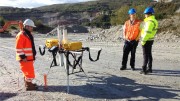Over the past year in the mining industry, we have seen many impairments and writedowns, project cancellations, project postponements, capital spending cuts, profit downgrades and reported net-income losses. Not surprisingly, this has affected CEO compensation.
Since 2001, Hay Group has conducted an annual global study of executive compensation for the largest producing miners, in countries including Australia, Canada, Chile and the U.S.
Our 2013 study consisted of over 2,000 executives from more than 240 business units. From 2012 to 2013, we observed the following high-level trends in these four countries: actual base salary slightly increased — 4.3% in Australia, 3% in Chile, 3.5% in Canada and 3.5% in the U.S.; actual short-term incentive payouts decreased in all four countries; target short-term incentive payout remained relatively flat in all four countries; the present value of mid- to long-term incentives increased slightly for Canada and the U.S., decreased slightly for Australia and was flat for Chile; and in terms of compensation mix, North American mining organizations have the highest at-risk pay, with almost 70% of their pay in short- and long-term incentives for executive positions, while Australian pay packages have almost 50% of their package in base salary.
These are challenging times for CEOs. For the past several years, Hay Group has also tracked the relationship between CEO pay and company performance of 27 global mining organizations. We do this to observe CEO compensation changes in response to the cyclicality of the mining industry and the increasing scrutiny from corporate governance and shareholder movement.
In 2013, this study observed significant changes in CEO compensation for the 2012 fiscal year: overall, we have found a decline in CEO Total Direct Compensation when comparing year-over-year analysis for the same CEO; diversified mining company CEOs saw a 20% compensation decrease; base-metal mining company CEOs saw a 12% compensation decrease; precious-metals mining company CEOs saw a 3% decrease; and coal-and-fuel mining company CEOs saw a 13% decrease.
Compared to 2011, financial metrics such as market capitalization, revenue, net income and total shareholder return showed a general decline. Compared to a year ago, there was less emphasis on earnings-related metrics. Our research indicates the mining community has shifted towards the more management “controllable” metrics, such as sustainability, health and safety, and production and operational (including unit cost) metrics. CEO actual total cash and total direct compensation also declined. The decline mostly reflects reduced actual short-term incentive and long-term incentive.
With respect to CEO turnover, 2012 was unprecedented for our group of 27 top global-mining organizations, as 37% of the companies announced or had a CEO change, of which five were major precious metal-mining companies.
When we extend the reference period to include the first half of 2013, the CEO turnover rate shoots up to 52%. Several departed CEOs could easily be linked to poorly timed acquisitions, overpriced acquisitions, cost overruns or capital blowouts, resulting in poor use of shareholder equity.
However, when examining CEO change in the S&P/TSX 60 during 2011–2013, mining organizations had a lower CEO turnover percentage (27%) when compared to the energy (60%) and consumer discretionary (50%) industries, but higher than financial services (20%).
Looking ahead, mining companies will likely face challenges over the coming year. As most of the mining companies are price takers, their core business is about extracting ore out of the ground cheaply and safely. Over the past year, we heard a lot of discussion about focusing on return and efficiency as the main consideration for incentive purposes. CEOs are asked to invest scarce capital wisely while their companies go into another year of uncertainty and volatility. It is likely we will see greater use of return on investment and efficiency performance metrics.
We observed that a number of mining organizations — especially gold miners — have announced aggressive company wide cost-cutting programs. It is likely that the boards would exercise judgment in adjusting incentive grants and awards by evaluating the companies’ financial health, projected cash flow, capital spending and future risks.
While the mining industry may not yet be entering an era of austerity, the caution of outsize executive remuneration packages is certainly real.
— Based in Toronto, Christopher Chen is national director for executive compensation at Hay Group and a member of the firm’s executive reward global-leadership team. He is a former lawyer and compensation director, and has worked with private- and public-sector clients across Canada in the areas of corporate governance, compensation strategy, competitive benchmarking and incentive design. He can be reached at christopher.chen@haygroup.com.
Anand Parsan is senior principal in Hay Group’s executive compensation practice, based in Toronto. He has practiced as an HR professional for over 15 years locally and internationally, and offers strategic and technical skills based on his years of consulting and industry experience. Anand is a trusted advisor to board members and management, and is an expert in the design and implementation of corporate governance and compensation programs that support organizational strategy and objectives, as well as shareholders’ interests.
Hay Group is a global management consulting firm with over 3,000 employees working in 87 offices in 49 countries, with clients in every major industry. Visit www.haygroup.com for more information.




Be the first to comment on "Commentary: Pay packages shrink for mining execs"